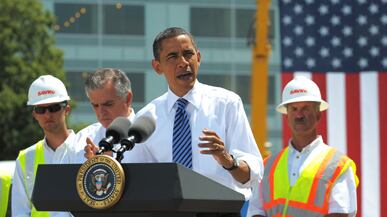Tucked into the stimulus package signed into law two years ago was a $30 billion wallop aimed directly at jump-starting the jobs market. The funds were designated for infrastructure spending and handed over to the states. Injecting money into transportation projects, the thinking goes, is an especially potent jobs-creation tool because it not only puts construction workers and contractors to work quickly, it also lays the groundwork for future economic growth and development. Obama predicted the transportation money alone would put hundreds of thousands of workers on the job.

It was a nice idea. Today the unemployment rate is hovering above 9 percent—better than it would have been without the stimulus, most experts agree, but still painfully high. Why didn’t we get more for our money?
While liberals and conservatives alike blame the stimulus itself—It wasn’t big enough! It was never going to work!—the problem may have more to do with how the money was spent. It’s not enough just to inject money into infrastructure, because not all transportation funding is created equal—or at least, it doesn’t create jobs at an equal rate. As any infrastructure policy wonk can tell you, money spent on fixing up existing systems or building mass transit delivers more jobs, and faster, than building new highways. With their wallets bulging with their federal allowance, the states were allowed to spend $26.6 billion of the American Recovery and Reinvestment Act money however they saw fit.
A new study shows that most states didn’t end up making the most of the windfall. The report by the transportation research group Smart Growth America found that states spent more than a third of the money on building new roads—rather than working on public transportation and fixing up existing roads and bridges. The result of the indiscriminate spending? States missed out on potentially thousands of new jobs—and bridges, roads, and overpasses around the country are still crumbling. Meanwhile, the states that did put dollars toward public transportation were richly rewarded: Each dollar used on transit was 75 percent more effective at putting people to work than a dollar used for highway work.
The government meant to get the biggest bang for its buck, with “shovel-ready projects.” But building miles of new roads requires planning, land acquisition, and other lengthy steps that put fewer workers on the job immediately.
The government, of course, meant to get the biggest bang for its buck. The stimulus bill forced states to spend their allocated cash quickly, which was intended to get them to fund maintenance needs—“shovel-ready projects”—that had already been identified. Building miles of new roads, on the other hand, requires planning, land acquisition, and other lengthy steps that put fewer workers on the job immediately.
Some states did that. Sue Minter, Vermont’s deputy transportation secretary, says a longstanding “fix-it-first” policy for infrastructure and bipartisan collaboration shaped Vermont’s decisions about how to use the funds. The state spent all of its highway money on system maintenance, with a small amount going to mass transit. (Minter, a Democrat, was a member of the state legislature at the time.) “This shot of money into our economy was very, very significant. It’s part of the reason we have a relatively low unemployment rate,” she says. Only 5.8 percent of Vermont residents are out of work, one of the nation’s lowest rates. State research shows that ARRA funding employed 11,000 people—a small number overall, but a significant one in a small state. Minter says the maintenance was important for keeping economic growth, particularly in tourism, strong.
Other states, however, took a different tack. Arkansas used 81 percent of its money for new projects and none on transit; it also has a higher unemployment rate than Vermont. And unlike other states near the bottom of the list, just 38 percent of its roads are in good condition, according to a report by the American Association of State Highway and Transportation Officials, a trade organization.
The state’s approach mirrors the model the federal government uses for routine infrastructure appropriations to the states, sometimes derided as the “peanut butter” system: Spread the money across the board. Arkansas State Highway and Transportation Department spokesman Glenn Bolick says the commission was to make sure the money reached workers in a variety of different industries across the state. “Our philosophy was that was how to spread economic development opportunities,” he says. “We were making the attempt to stimulate all the different types of contractors all across the state.”
So why not tie funding to results? “As Congress is the overseer of responsibly spending federal taxpayer money, there ought to be some requirement of results,” says Geoff Anderson, president of Smart Growth. Approaching infrastructure policy from a jobs-first angle has drawbacks, too, says Nicole Gelinas, a fellow at the Manhattan Institute, a right-leaning think-tank. It’s important to give states some leeway, she says, or else we risk ending up with superfluous projects—light-rail lines to nowhere instead of the fabled bridge to nowhere. “They say public transport creates more jobs per dollar spent versus new things,” Gelinas says. “I’m all for public transport where there’s the density, but I don’t think the emphasis should be on job creation. It should be, does the economy need this?”
With President Obama calling for further transportation funding in his State of the Union address last month, the federal government may soon be writing more checks to the states. Although Republicans have pledged to cut spending, House Majority Leader Eric Cantor, who has spoken about the poor state of the nation’s infrastructure, is likely to get on board. Infrastructure spending has traditionally been popular with voters.
And any stipulation on how to spend the money is unlikely this time around, too. Congress has repeatedly failed to pass a long-term, comprehensive transportation bill that could include guidance on spending. Instead, they’ve passed extensions to the now-expired SAFETEA-LU bill, and if they do so again, the old system—which gives states significant leeway—could stay in place during future spending, raising the specter of dollars inefficiently spent. Again.





